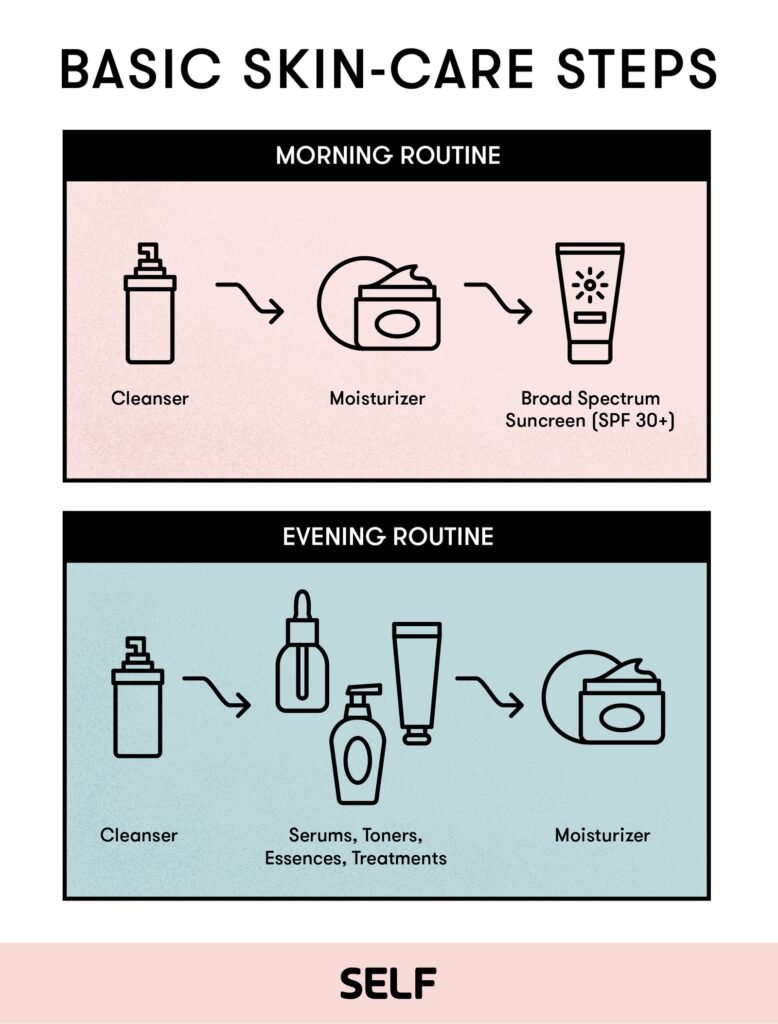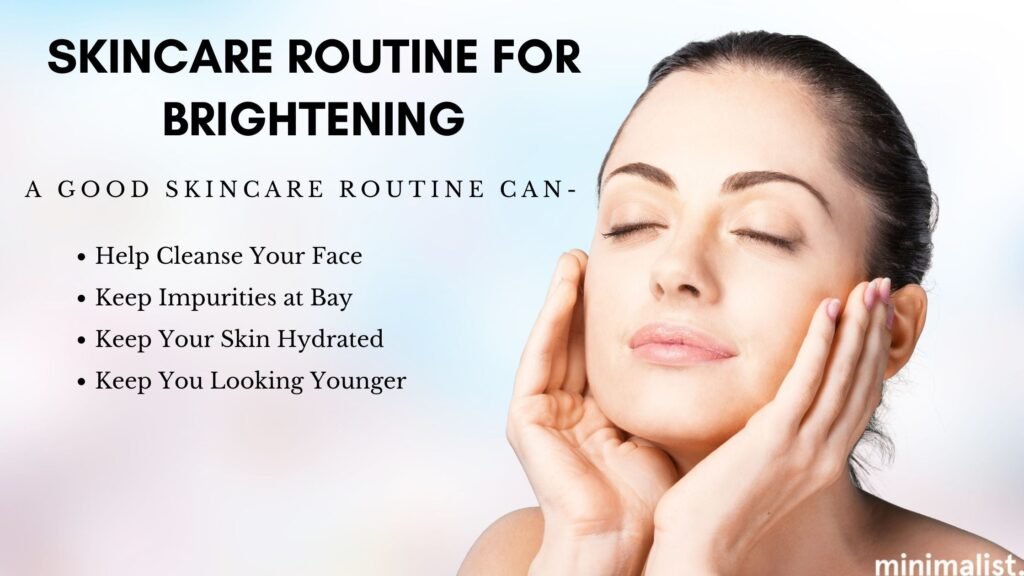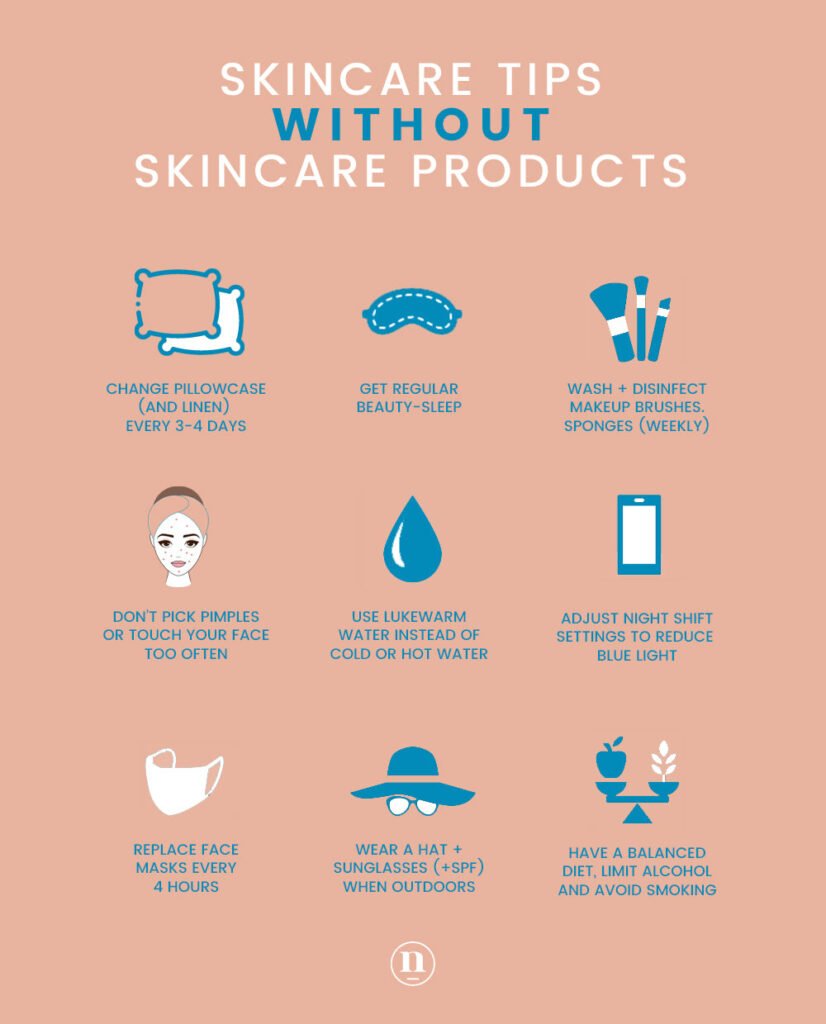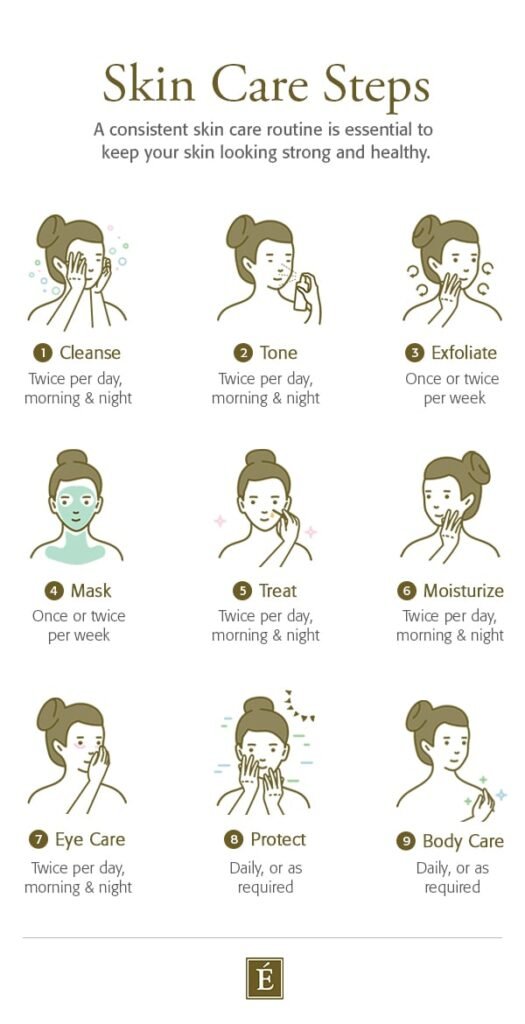How Can You Create A Simple Yet Effective Skincare Routine Using Minimal Products?
In this article, you will discover how to effortlessly develop a skincare routine that is both uncomplicated and yields impressive results, all with just a few essential products. By utilizing the most effective keywords for optimal SEO optimization, we will explore the question of how you can achieve a simple yet effective skincare routine with minimal items. Join us as we unveil the secrets to glowing, healthy skin that won’t require an overwhelming array of products.
Identify your skin type
Knowing your skin type is crucial
When it comes to developing an effective skincare routine, the first step is to identify your skin type. Understanding your skin type is crucial as it helps you choose the right products and treatments that cater to your specific needs. Skin types generally fall into five categories: dry, oily, combination, sensitive, and normal. Take some time to observe your skin and determine which category it falls into. This will serve as the foundation for your skincare routine.
Dry skin
If you have dry skin, you may experience tightness, flakiness, and a dull complexion. Dry skin lacks moisture and tends to feel rough and dehydrated. To take care of dry skin, opt for hydrating cleansers and moisturizers that lock in moisture and prevent water loss from the skin. Look for ingredients such as hyaluronic acid and ceramides, which help restore and maintain hydration levels in the skin.
Oily skin
On the other end of the spectrum, oily skin is characterized by excessive sebum production, resulting in a shiny complexion and enlarged pores. Those with oily skin may also be prone to breakouts and acne. To manage oily skin, choose gentle, non-comedogenic cleansers that effectively remove excess oil without stripping the skin of its natural moisture. Look for ingredients like salicylic acid or tea tree oil, which can help control sebum production and prevent acne.
Combination skin
Combination skin is a mix of oily and dry areas on the face. Typically, the T-zone (forehead, nose, and chin) tends to be oily, while the cheeks may feel dry or normal. Finding the right balance for combination skin can be challenging, but it’s not impossible. Look for products that cater to both oily and dry skin, such as a gentle cleanser that removes excess oil without drying out the skin, and a lightweight moisturizer that hydrates without adding additional oil.
Sensitive skin
Sensitive skin is easily irritated and prone to redness, itching, and reactions to certain ingredients or environmental factors. If you have sensitive skin, it’s crucial to choose gentle, fragrance-free, and hypoallergenic products. Look for skincare products specifically formulated for sensitive skin, and avoid harsh ingredients such as alcohol, fragrances, and dyes. Conduct a patch test (discussed later) before incorporating new products into your routine to avoid any adverse reactions.
Normal skin
Consider yourself lucky if you have normal skin. Normal skin is well-balanced and neither too oily nor too dry. It has a smooth texture, minimal imperfections, and is generally not sensitive. With normal skin, you have more flexibility when choosing products for your skincare routine. However, it’s still important to keep your skin hydrated and protected from external factors.
Consult with a dermatologist if unsure
If you’re unsure about your skin type or if you have specific concerns, it’s always a good idea to consult with a dermatologist. They can assess your skin, provide personalized advice, and recommend suitable skincare products tailored to your needs. Dermatologists can also help address any underlying skin conditions and guide you towards achieving healthy, radiant skin.
Cleansing
Choose a gentle cleanser
Cleansing is an essential step in any skincare routine as it removes dirt, oil, and impurities that can accumulate on the skin throughout the day. When choosing a cleanser, opt for a gentle formula that effectively cleanses your skin without stripping it of its natural oils. Look for cleansers with a pH-balanced formulation, as this helps maintain the skin’s natural barrier function and prevents dryness.
Avoid harsh or stripping ingredients
Avoid cleansers that contain harsh ingredients such as sulfates, alcohol, or fragrances, as they can irritate and dry out the skin. These ingredients can disrupt the skin’s natural balance and lead to sensitivity, redness, and even breakouts. Instead, opt for cleansers that are free from these potentially irritating substances and are specifically formulated for your skin type.
Cleanse twice a day
It’s important to cleanse your skin twice a day – once in the morning and once at night – to maintain a clean and healthy complexion. Cleansing in the morning helps remove any impurities that may have accumulated overnight, while cleansing at night removes dirt, oil, and makeup from the day. Be sure not to skip this step, as it can lead to clogged pores, breakouts, and dull-looking skin.
Proper cleansing technique
To get the most out of your cleanser, it’s important to use the proper technique. Start by wetting your face with lukewarm water, as hot water can strip the skin of its natural oils. Apply a small amount of cleanser to your fingertips or a cleansing brush and gently massage it onto your face using circular motions. Pay extra attention to areas prone to oiliness or congestion, such as the T-zone. Rinse thoroughly with water and pat your face dry with a clean towel.
Consider using a cleansing brush or cloth
If you want to take your cleansing routine to the next level, consider incorporating a cleansing brush or cloth. These tools can help exfoliate the skin and remove dead skin cells, resulting in a smoother, more radiant complexion. However, be cautious if you have sensitive skin, as these exfoliating tools can potentially cause irritation. Start with gentle pressure and observe how your skin reacts before making it a regular part of your routine.

This image is property of media.self.com.
Exfoliation
Why exfoliation is important
Exfoliation is a crucial step in your skincare routine as it helps remove dead skin cells, unclog pores, and improve skin texture. By sloughing away the buildup of dead skin cells, you can reveal fresher, brighter skin underneath. Regular exfoliation also enhances the absorption of skincare products, allowing them to penetrate deeper into the skin for better results.
Use a chemical exfoliant
When it comes to exfoliation, chemical exfoliants are often preferred over physical exfoliants. Chemical exfoliants contain ingredients such as alpha hydroxy acids (AHAs) or beta hydroxy acids (BHAs) that break down the bonds between dead skin cells, allowing them to be easily sloughed away. AHAs, such as glycolic acid and lactic acid, are ideal for dry or sensitive skin, while BHAs, such as salicylic acid, are more suitable for oily or acne-prone skin. Follow the instructions on the product for proper application and frequency.
Physical exfoliation alternatives
If you prefer physical exfoliation or have thicker, less sensitive skin, there are alternative options available. However, be cautious as physical exfoliation can be harsh on the skin if not done properly. Opt for gentle exfoliating scrubs or cleansing brushes with soft bristles. Avoid abrasive materials such as walnut shells or fruit pits, as they can cause micro-tears in the skin and lead to irritation. Remember, less is more when it comes to physical exfoliation – aim for once or twice a week to avoid over-exfoliating.
Frequency of exfoliation
The frequency of exfoliation depends on your skin type and the product you’re using. As a general guideline, start with once a week and gradually increase to no more than three times a week if your skin tolerates it well. Be mindful of how your skin reacts and adjust accordingly. It’s important not to over-exfoliate, as this can compromise the skin barrier and lead to increased sensitivity and dryness.
Be cautious with sensitive skin
If you have sensitive or easily irritated skin, exfoliation can be tricky. It’s best to opt for gentle chemical exfoliants, such as PHA (polyhydroxy acids), which are milder and less likely to cause irritation. Start with a low concentration and infrequent use to gauge your skin’s reaction. Remember to always hydrate and moisturize your skin afterwards to minimize any potential dryness or sensitivity.
Moisturizing
Importance of moisturizing
Regardless of your skin type, moisturizing is a crucial step in any skincare routine. Moisturizers help nourish and hydrate the skin, keeping it supple, plump, and youthful-looking. They also help restore the skin’s natural barrier function, preventing moisture loss and protecting it from environmental stressors. Even if you have oily skin, moisturizing is essential to maintain a healthy balance and prevent excessive oil production.
Choose a suitable moisturizer
Choosing the right moisturizer for your skin type is essential. For dry skin, opt for richer, more emollient moisturizers that provide intense hydration. Look for ingredients like hyaluronic acid, shea butter, or ceramides, which help lock in moisture and replenish the skin’s barrier. If you have oily skin, choose lightweight, oil-free moisturizers that provide hydration without adding extra shine. Gel or water-based moisturizers are often ideal for oily skin types.
Consider additional hydration options
To give your skin an extra boost of hydration, consider incorporating additional hydration options into your routine. Serums or essences can provide a concentrated dose of moisture, delivering active ingredients deeper into the skin. Look for serums with hyaluronic acid, vitamin C, or niacinamide, which can help hydrate and brighten the skin. Consider layering these products under your moisturizer for maximum hydration benefits.
Apply moisturizer on damp skin
For optimal absorption, apply your moisturizer on damp skin. After cleansing, gently pat your face dry with a towel, leaving some moisture on the skin. This helps lock in hydration and allows the moisturizer to penetrate more effectively. Apply a pea-sized amount of moisturizer and gently massage it into your skin using upward motions. Don’t forget to include your neck and chest in your moisturizing routine, as these areas are often neglected but show signs of aging too.
Don’t forget the delicate eye area
The delicate skin around the eyes requires special attention and care. The skin in this area is thinner and more prone to dryness and fine lines. Using a targeted eye cream can help hydrate and minimize the appearance of dark circles, puffiness, and crow’s feet. Look for eye creams that are specifically formulated for the delicate eye area, avoiding heavy or greasy textures that can lead to milia or clogged pores. Gently pat the eye cream around the orbital bone, avoiding direct contact with the eyes.

This image is property of intentionalview.com.
Sun Protection
Why sun protection is crucial
One of the most important steps in any skincare routine is sun protection. Exposure to harmful UV rays can lead to premature aging, dark spots, and an increased risk of skin cancer. Protecting your skin from the sun’s harmful rays is crucial for maintaining healthy, youthful-looking skin. Even on cloudy days or during the winter months, UV rays can still penetrate your skin, so it’s important to make sun protection a daily habit.
Choose a broad-spectrum sunscreen
When it comes to sunscreen, choose a broad-spectrum formula that offers protection against both UVA and UVB rays. UVA rays are associated with premature aging and can penetrate deeper into the skin, while UVB rays cause sunburns and play a role in the development of skin cancer. Look for sunscreens with SPF 30 or higher, as they provide adequate protection against both types of rays.
SPF recommendations
The American Academy of Dermatology recommends using a sunscreen with a minimum SPF of 30. However, if you’re spending an extended amount of time outdoors or participating in activities that make you more susceptible to sun exposure, consider using a higher SPF, such as 50 or above, for added protection. Remember to apply sunscreen generously and evenly to all exposed areas of your skin.
Reapply sunscreen as needed
Sunscreen should be reapplied every two hours or more frequently if you’re swimming, sweating, or rubbing your face. Even if you’re using a water-resistant sunscreen, it’s important to reapply regularly, as water and towel drying can remove the product from your skin. Consider setting reminders or using sunscreen with built-in timers to ensure you stay protected throughout the day.
Cover up and seek shade
In addition to sunscreen, it’s important to take other sun protection measures. Seek shade whenever possible, especially during the peak hours of 10 am to 4 pm when the sun’s rays are strongest. Wear protective clothing such as wide-brimmed hats, long-sleeved shirts, and pants to shield your skin from direct sunlight. Don’t forget to wear UV-blocking sunglasses to protect your eyes from harmful rays.
Targeted Treatment
Address specific skin concerns
In addition to the basic steps of cleansing, exfoliating, moisturizing, and sun protection, you may choose to incorporate targeted treatments into your skincare routine. These treatments can help address specific skin concerns and provide additional benefits for your skin. Whether you’re dealing with acne, aging skin, or hyperpigmentation, there are products available to target these concerns and help you achieve your desired results.
Acne treatments
For those struggling with acne-prone skin, incorporating acne treatments into your routine can help control breakouts and promote clearer skin. Look for products containing ingredients like benzoyl peroxide, salicylic acid, or retinoids, which can help unclog pores and reduce inflammation. These treatments can be used as spot treatments or applied to the entire affected area, depending on the severity of your acne.
Anti-aging products
If your goal is to combat signs of aging and maintain youthful-looking skin, anti-aging products can be beneficial. Look for products with ingredients like retinol, peptides, hyaluronic acid, or antioxidants, which can help reduce the appearance of fine lines, wrinkles, and age spots. These products can also improve skin elasticity and firmness, giving you a more youthful complexion.
Hyperpigmentation solutions
Hyperpigmentation, such as dark spots or uneven skin tone, can be a common concern for many individuals. To address this, look for products with ingredients like vitamin C, niacinamide, or kojic acid, which can help brighten the skin and fade pigmentation over time. Incorporating these products into your routine can help even out your skin tone and promote a more radiant complexion.
Consult with a dermatologist for personalized advice
For more severe or persistent skin concerns, it’s always best to consult with a dermatologist. They can assess your skin, provide personalized advice, and recommend specific treatments or prescription-strength products that are best suited for your needs. A dermatologist can also monitor your progress and make adjustments to your skincare routine as necessary.

This image is property of cdn.shopify.com.
Simplify your routine
Assess your current skincare products
As you progress in developing your skincare routine, assess your current collection of skincare products. Check the labels and ingredient lists of each product to understand what they do and whether they are suitable for your skin type and concerns. This step will help you determine which products are essential and which ones can be eliminated or replaced.
Identify essential products
Essential products in a simplified skincare routine typically include a gentle cleanser, moisturizer, sunscreen, and targeted treatments for specific concerns. These products cover the basic steps of cleansing, hydrating, and protecting your skin while addressing any specific issues you may have. By focusing on these essential products, you can streamline your routine and still achieve great results.
Avoid unnecessary steps
In a minimalistic skincare routine, it’s important to avoid unnecessary steps or products that do not provide significant benefits to your skin. Assess each step of your routine and eliminate any redundant or repetitive products. For example, if your moisturizer already contains SPF, you may not need to use a separate sunscreen. Simplifying your routine eliminates clutter and saves you time and money.
Consider multi-purpose products
To further simplify your routine, consider using multi-purpose products that offer multiple benefits in one. For example, a tinted moisturizer with SPF can provide hydration, sun protection, and light coverage, combining three steps into one. Look for products that cater to your specific needs and provide multiple benefits, reducing the number of products required in your skincare routine.
Streamline your routine for consistency
To achieve the best results, consistency is key. Once you have identified your essential products and simplified your routine, it’s important to stick to it consistently. Consistency allows your skin to adapt and benefit from the products over time. Avoid excessive switching or introducing too many new products at once, as this can disrupt your skin’s balance and potentially cause adverse reactions.
Patch test new products
Importance of patch testing
Before incorporating new products into your skincare routine, it’s essential to patch test them first. Patch testing involves applying a small amount of the product on your inner arm or a discreet area of your face and observing for any adverse reactions. This step helps identify potential allergies or sensitivities to the product before applying it to your entire face.
Apply a small amount on your inner arm
To conduct a patch test, start by applying a small amount of the product on your inner arm or a small area of your face. Avoid applying it to any broken or irritated skin. Gently massage or pat the product into the skin and leave it on for 24 hours. During this time, avoid washing the area or applying any other products to ensure accurate results.
Observe for any adverse reactions
After 24 hours, observe the patch test area for any adverse reactions. Look for signs of redness, itching, burning, or inflammation. If you experience any discomfort or irritation, it’s best to avoid using the product on your face. On the other hand, if there are no adverse reactions, it is generally safe to incorporate the product into your skincare routine.
Wait at least 24 hours before further use
Even if you don’t experience any immediate adverse reactions, it’s still important to wait at least 24 hours before further use of the product. Some reactions can occur with delayed onset, so giving your skin sufficient time to react is crucial. If your skin remains clear and unaffected after this period, you can confidently continue using the product as directed.
Avoid using if allergic reactions occur
If you experience any allergic reactions or severe irritation during the patch test, it’s important to discontinue use of the product immediately. Allergic reactions may manifest as hives, swelling, or difficulty breathing. If symptoms worsen or persist, seek medical attention as soon as possible. It’s always better to err on the side of caution when it comes to your skin’s health and safety.

This image is property of cdn.shopify.com.
Stay consistent
Consistency is key for results
When it comes to skincare, consistency is key for achieving optimal results. Your skincare routine won’t be effective if you only follow it sporadically or constantly switch products. Stick to your chosen routine and be patient – it takes time for skincare products to work and show visible improvements. Consistency allows your skin to adjust and experience the long-term benefits of the products you’re using.
Stick to your chosen routine
Choose a skincare routine that works for you and stick to it. Follow the steps consistently, using the chosen products as directed. It’s important to give your skin time to adapt and for the products to work their magic. Resist the temptation to switch products frequently or try every new skincare trend that comes along. Not only can this be overwhelming, but it can also disrupt your skin’s balance and hinder progress.
Give products enough time to work
Skincare products usually require time to show visible results. While some products may produce immediate effects, most will require continued use over several weeks or months to see significant changes. Be patient and give your products enough time to work before making judgments or deciding to switch. If you’re uncertain about a product’s efficacy, consult with a dermatologist for guidance.
Avoid excessive switching
Switching products too frequently can make it difficult to assess the effectiveness of each individual product. Your skin needs time to adjust to new ingredients, and changing products too often can disrupt this process. Stick with your chosen routine for at least six to eight weeks before considering any additions or replacements. This timeframe allows your skin to adapt and for you to clearly evaluate the results.
Adjust as needed based on skin’s response
Monitoring your skin’s response is important throughout your skincare journey. Pay attention to how your skin feels and looks after each step of your routine and assess whether any adjustments are needed. If you notice any adverse reactions, such as increased dryness, irritation, or breakouts, it may be an indication that a particular product is not suitable for your skin. Consider scaling back, substituting products, or consulting with a dermatologist for personalized advice.
Additional tips
Stay hydrated
Good skincare starts from within, and hydration plays a vital role in maintaining healthy skin. Drink plenty of water throughout the day to keep your body and skin hydrated. Water helps flush out toxins and promotes a clear, radiant complexion. Remember to adjust your water intake depending on factors such as climate, activity level, and overall health.
Maintain a healthy lifestyle
Skincare goes hand in hand with a healthy lifestyle. Eating a balanced diet, exercising regularly, and getting sufficient sleep can all contribute to better skin health. Consuming a variety of fruits, vegetables, lean proteins, and whole grains provides essential vitamins and antioxidants that nourish your skin from the inside out. Regular exercise improves blood circulation and promotes a healthy glow. Sufficient sleep allows your skin to repair and regenerate, leading to a more refreshed appearance.
Protect your skin from environmental factors
Environmental factors such as pollution, harsh weather conditions, and free radicals can take a toll on your skin’s health. Protect your skin by wearing appropriate clothing, seeking shade when necessary, and using skincare products that contain antioxidants. Antioxidants help neutralize free radicals and protect your skin from oxidative stress. Look for ingredients like vitamin C, vitamin E, or green tea extract in your skincare products.
Avoid over-washing
While cleansing is an important step in your skincare routine, over-washing can strip the skin of its natural oils and disrupt its balance. Stick to cleansing twice a day – once in the morning and once at night – unless otherwise recommended by a dermatologist. If your skin feels dry or tight after cleansing, consider using a gentler cleanser or adjusting the frequency of cleansing to avoid excessive dryness.
Don’t forget your neck and chest
When it comes to skincare, it’s essential to extend your routine beyond just the face. The skin on your neck and chest is delicate and can show signs of aging and sun damage. Apply the same products you use on your face, such as cleanser, moisturizer, and sunscreen, to these areas as well. Remember to use upward motions when applying products to the neck and chest to help maintain skin elasticity.
Remove makeup before bed
Sleeping with makeup on can clog pores, lead to breakouts, and prevent your skin from effectively renewing and repairing overnight. Make it a habit to remove your makeup thoroughly before going to bed. Use a gentle makeup remover, followed by your regular cleanser, to ensure that no traces of makeup are left on your skin. This step allows your skin to breathe and promotes a fresh, clear complexion.
By following these guidelines and developing a simple yet effective skincare routine tailored to your skin’s needs, you can achieve healthier, more radiant skin. Remember to listen to your skin, stay consistent, and seek professional advice when needed. With a little effort and the right products, you’ll be on your way to glowing, beautiful skin.

This image is property of info.eminenceorganics.com.


